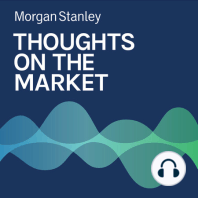3 min listen

Mike Wilson: A Historically Concentrated Market
Mike Wilson: A Historically Concentrated Market
ratings:
Length:
5 minutes
Released:
Jun 12, 2023
Format:
Podcast episode
Description
With AI gaining momentum among investors and the Fed potentially pausing on rate hikes, signs are now pointing towards the end of the bear market rally.----- Transcript -----Welcome to Thoughts on the Market. I'm Mike Wilson, Chief investment Officer and Chief U.S. Equity Strategist for Morgan Stanley. Along with my colleagues, bringing you a variety of perspectives, I'll be talking about the latest trends in the financial marketplace. It's Monday, June 12th at 11 a.m. in New York. So let's get after it. At the beginning of the year, we noted that our view is much more in line with the consensus and we discussed that it might take some time for that to change. Suffice it to say, it has taken longer than we expected. At the end of January, sentiment and positioning had improved enough to put stocks in a vulnerable state, and sure enough, we had a 10% correction in the S&P 500 over the following six weeks, with the average stock down about 13%. Since then, the average stock has lagged the overall index by about 10%. We think this is mostly due to increased liquidity from the depositor bailouts, at the same time artificial intelligence began to gain momentum with investors. The combination of perceived safety and of newfound open ended growth story was too much for investors to resist. Hence, we have one of the most concentrated markets in history. For most of the past two months, sentiment has remained somewhat pessimistic, which is part of the reason why the average stock hasn't done very well. But sentiment has turned outright bullish in the past week. Furthermore, it's not just sentiment, as both retail and institutional flows have returned to the equity markets with technology and artificial intelligence the dominant themes. This past week there were several other warning signs that this bear market rally may have finally exhausted itself after eight months. First, several sell side strategists and market commentators have publicly stated the bear market is now over at this point. Second, we don't find much value in the 20% threshold for declaring new bull markets. Instead, our conclusion is driven more by the fundamentals, valuations and expectations relative to our outlook. In short, our earnings view is much more pessimistic than the current consensus expectation, which is now assuming a second half reacceleration story. We can also find several instances of bear market rallies that exceeded the 20% threshold, only to eventually give way to new lows. One example is particularly relevant, given our 1940s and fifties boom bust framework that we discussed in last week's podcast. After the boom in 1946, following the end of the war, the S&P 500 corrected by 28%, followed by a 24% choppy bear market rally that lasted almost eighteen months before succumbing to new lows a year later. Thus far, it appears similar to the current bear market, which corrected 27 and a half percent last year and is now rallied 24% from its intraday lows, but is still 10% below the highs. Third, when we called for a bear market rally last October, it was predicated on two key assumptions. First, market concern around the Fed and terminal rate had likely peaked, and second, the US dollar was also peaking. Both of these developments occurred as long term interest rates and the U.S. dollar topped last October. Falling rates and the US dollar have combined to drive both valuations and earnings expectations higher. On the latter point, the U.S. dollar index is now flat on a year-over-year basis, which compares to up 21% at its peak last fall. The question is how much did a weaker dollar help the top line for multinational companies and the S&P 500 overall? Furthermore, will this dollar weakness continue or will it flatten out and or even reverse into a headwind? It's hard to know for sure, but our house view is for a stronger dollar, and it's important to acknowledge the S&P 500 has become very negatively correlated to the dollar over the last decade. Fin
Released:
Jun 12, 2023
Format:
Podcast episode
Titles in the series (100)
Andrew Sheets: For Markets, Signs, Signs, Everywhere Signs by Thoughts on the Market